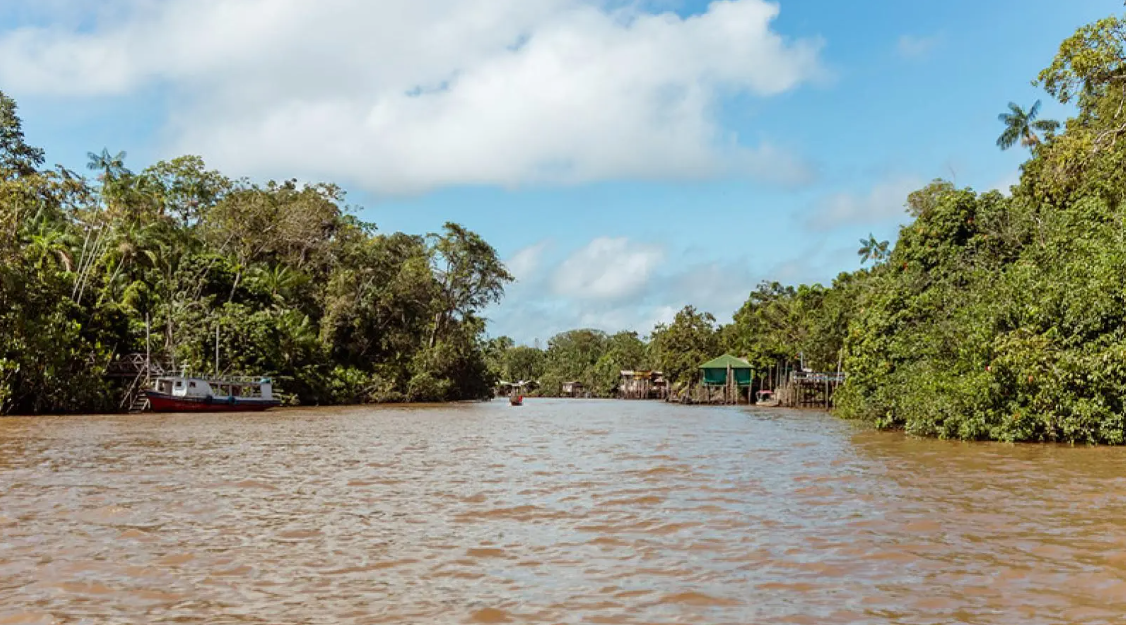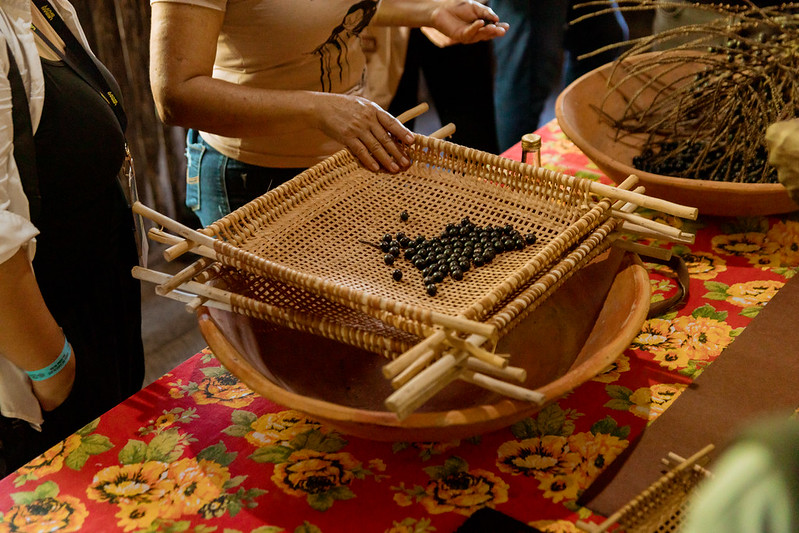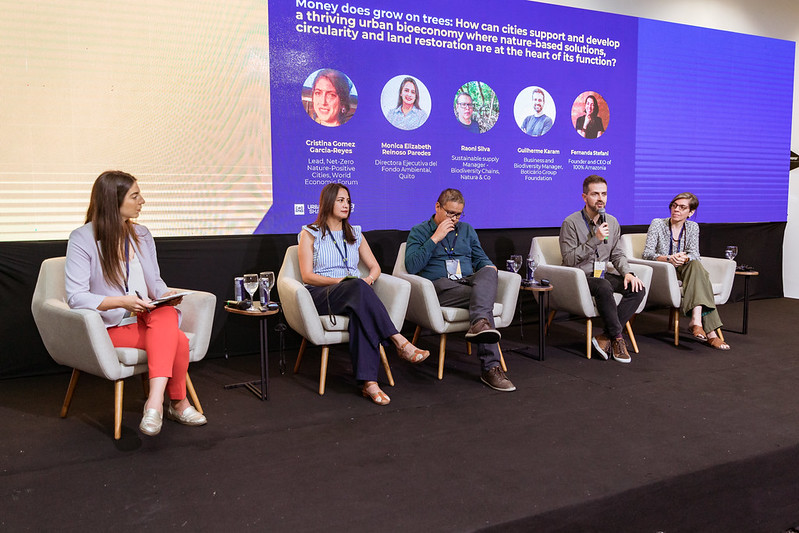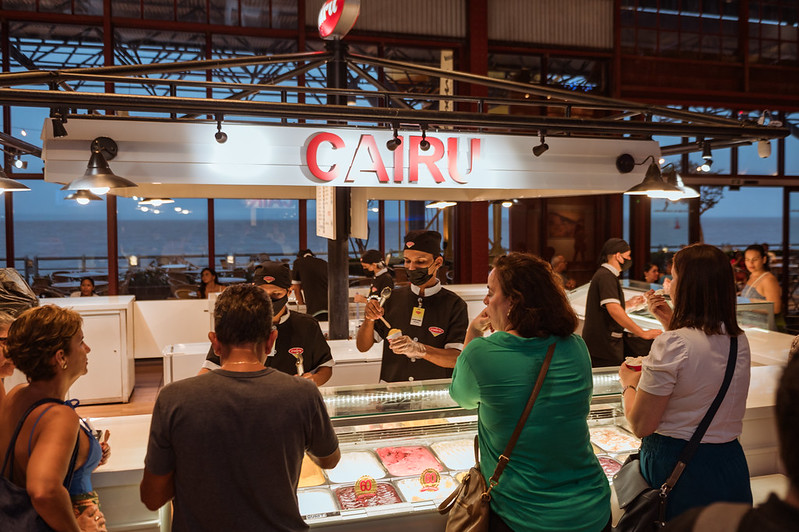
Departing from the Amazonian city of Belém, Brazil, in a speedboat, it takes around 10 minutes to reach the shores of Combu Island. As the skyline fades into the distance, the lush, green environment of the island comes into view and time seems to slow down. Along the shores of Combu Island, ribeirinhos (in English, “river people”)– traditional rural inhabitants of the Amazon rainforest who live near rivers – navigate the waters in their own boats, cutting through the thick vegetation that borders the island. For centuries, residents of Combu Island and the surrounding region have lived in concert with the land: fishing the waters and harvesting local produce like cacao, açai and cupuaçu.
Now, the island’s bounty has become its economic engine. Just inland from the docks is Saldosa Maloca. Since the restaurant’s founding in 1982, it’s spurred the island’s transformation into a culinary destination and innovation hub. Founded to showcase the diversity and delicacy of the island’s natural resources, the eco-friendly restaurant shows how consideration for natural ecosystems and what they produce can create the backbone of a thriving and sustainable enterprise.

“Forty-two years ago, my parents founded this restaurant,” Prazeres Quaresma dos Santos, owner and chef of Saldosa Maloca, told UrbanShift. “Being residents of the island, with our whole family living here, we are very concerned about issues of sustainability.” Dos Santos described how living in such close proximity to the resources that support the restaurant informed her family’s approach. “On an island, you must think circularly; everything is reused here. For instance, we have developed a biodigester that produces biogas from the restaurant residues such as compounding of fish, chicken, etc., that is then used in the kitchen to make the food we serve in the restaurant. It is like a circle.”
Nearby on the island, Filha do Combu (in English “Daughter of Combu”) takes a similarly thoughtful approach to the production of its chocolate, which has caught the attention of several renowned Brazilian chefs. Since 2006, the tree-to-bar chocolate factory harvests cocoa pods and transforms them into organic chocolate products, employing traditional methods of harvesting and processing the seeds. By keeping all production local and owning the entire production chain – from harvesting to sales – Filha do Combu can ensure its profits stay local, directly benefitting their workers and community.
Saldosa Maloca and Filha do Combu are just two examples of local businesses in the Amazon advocating for a mindset shift in our current production system — a system that disconnects people from nature, creating an odd paradox in one of the world’s biodiversity hotspots.
During the recent UrbanShift Latin America Forum, hosted in Belém and focused on strategies to develop and finance more sustainable approaches to urban life, participants visited Combu Island to see how the vision for an urban economy attuned to natural cycles and resources can be a thriving, vibrant reality.
The Need for Transformation
The Brazilian Amazon offered a crucial context for the discussions and workshops that unfolded during the UrbanShift Latin America Forum. In this region, the dual pressures of urbanization and ecosystem degradation are palpable. Recently, urbanization has accelerated in the region: 75% of all residents and 40% of the Indigenous population now live in cities, and residents of the urban Amazon report a lower quality of life compared to residents of urban areas throughout the rest of Brazil. Driving urbanization in the Amazon is the spread of resource-intensive agriculture, livestock production and mining practices that erode natural ecosystems while delivering almost no benefits to local populations.
Although this incredibly biodiverse region plays a critical role in shaping the climate and supporting global food and medical supply chains, the Global North’s relationship to the Amazon and all that it has to offer has been built around extraction. Global systems plumb the region’s resources and disregard the needs of its residents – who grapple with endemic inequities and a lack of access to basic services – and the delicate balance of the ecosystem.
“You talk about the economy and all the benefits, but you need to actually look at who produces this economy – the people-focused aspect,” dos Santos said. “The government needs to look more at the local actors of the economy. We are part of driving the economy, but we do not even have drinkable water on the island.”
Traditional production related to nature, added José Mattos, Brazil Chapter Head for the Aspen Network of Development Entrepreneurs (ANDE), “does not directly benefit local communities.” There needs to be more recognition of the people who work directly with natural ecosystems, he said, and the critical need to sustain and regenerate these systems.
With Belém and the entire Amazon region as the backdrop, the UrbanShift Latin America Forum delved into the need to re-center vital ecosystems and their residents in the economy, and offered strategies for reimagining economic systems to support ecosystem health and residents’ well-being.
Growing an Urban Bioeconomy
How can cities collectively work to precipitate this economic shift? The C40 Cities-led City-Business Hub, hosted during the UrbanShift Latin America Forum, introduced participants to the concept of an urban bioeconomy: a paradigm-shifting framework that acknowledges the interdependence of ecosystems, people and climate. At its core, the idea of a bioeconomy represents a departure from traditional exploitative production models – or the linear “take, make, waste” model – toward a more sustainable and circular approach. It hinges around harnessing renewable biological resources, valorizing biowaste and fostering green infrastructure.
In biodiverse regions like the Amazon, transitioning to a bioeconomy model should prioritize preserving biodiversity, respecting local traditional knowledge and ensuring equitable distribution of economic benefits. Bioeconomy businesses often focus on utilizing renewable resources and adopting circular economy principles. This can lead to reduced resource consumption, waste generation and environmental impact within urban areas. By promoting resource efficiency, bioeconomy businesses contribute to the sustainability of cities by minimizing their ecological footprint.

During the City-Business Hub, the call from public and private sector leaders to reimagine systems around the idea of a bioeconomy came through loud and clear. “In cities, everything we receive is ready, and we tend to have biodiversity amnesia,” said Fernanda Stefani, CEO of 100% Amazonia, a B Corp that transforms renewable ingredients from the region into unique products. “There is an opportunity to connect the forest and the city better to develop a more integrated urban-rural economy. Forest and cities can be connected – in fact they need to be – as they depend on each other to survive.”
The Role of Public and Private Sectors
To translate the concept of a bioeconomy from an idea to a core part of the local economy, cities and businesses both have a critical role to play. In Belém – part of the Global Environment Facility-supported UrbanShift network in Brazil – the potential of cities to foster and support a bioeconomy is already visible. Just take a walk through the Docas Station: a reimagined industrial district along the city’s waterfront that now hosts numerous restaurants and cultural attractions. One of the hotspots is Cairu, the most popular ice cream shop in the city. They offer a large and unique variety of regionally specific ice cream flavors infused with ingredients sourced directly from Combu Island. It’s a small example, but a powerful illustration of what it means to be able to experience local biodiversity within a city. It’s specific, circular and tangible.

On a broader scale, Belém is establishing itself as a model of innovation and bioeconomy for the rest of Brazil. The city is a catalyst for public policies aimed at territorial requalification, economic and social development, and strengthening local production chains for biodiversity, innovation and the creative economy. With the support of WRI Brasil, the recent launch of Distrito de Inovação e Bioeconomia de Belém (in English, “Innovation and Bioeconomy District of Belém”), illustrates how cities can create enabling conditions for innovation, research, cultural exchange and territorial development. By collaborating with cooperatives, cultural associations, startups, and small- and medium-sized enterprises, this new bioeconomy district will foster sustainable commercialization of renewable products. In addition to supporting research and development of creative new approaches, it will soon offer coworking spaces, training courses in entrepreneurship, research grants and business incubation support for local businesses looking to enter the market.
While cities can set the policy frameworks and enabling conditions for an urban bioeconomy, businesses must also work to evolve their models to center the health and well-being of ecosystems and residents. Centering the compelling diversity of natural resources is essential, but so is working in ways that are conscious of the limits of healthy ecosystems. Identifying renewable resources, understanding and respecting ecosystem life-cycles, and repurposing by-products and waste can shift business models toward greater circularity and sustainability.
“Businesses need to understand their role in actioning and supporting the sustainable development from inside their business models, while securing the specificities of their realities and region,” said Raoni Silva, Supply Chain and Biodiversity Manager for Natura & Co. “The connection with the forest from people is strong, and we need to ensure this bioeconomy is developed. The demand for those products exists.”
—
The idea of an urban bioeconomy holds enormous potential to right-size the relationship between economic production and natural ecosystems. By placing nature – and the people who depend on and have stewarded it sustainably for centuries – at the center of business, the concept of a bioeconomy can unlock economic potential and support the collective prosperity of communities and the planet at large. It’s inspiring to see this concept already taking root in Belém and across the continent.
Quito, Ecuador, offers another example: As Mónica Reinoso Paredes, Executive Director of the Quito Environmental Fund, described, the city is implementing a blue-green ordinance to protect and restore natural areas in addition to establishing a funding mechanism for public-private alliances organized around nature-based solutions.
Other cities around the world can look to these models to spur implementation of circular practices that prioritize resource efficiency, improve waste management, support local entrepreneurs and biodiversity conservation, and cultivate a culture of innovation. By supporting local initiatives and entrepreneurs, and fostering collaboration with the private sector, cities can lead the way towards a more sustainable and equitable future.
A version of this article originally appeared on ShiftCities.com.
Eillie Anzilotti is Communications Lead for UrbanShift at WRI Ross Center for Sustainable Cities.
Amélia Maradas is City-Business Engagement Project Officer at C40.





